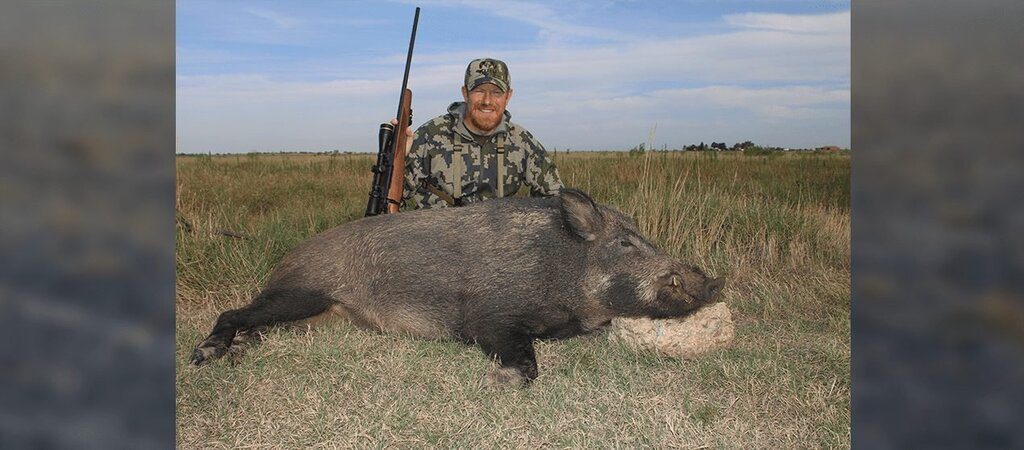
So many hogs, so many opportunities
By Brandon Ray Wild hogs have spread to every corner of Texas. It’s legal to hunt feral hogs in Texas year-round, day or night, with landowner permission. When I barely have enough money to fill my truck with gas, hog hunting is always nearby and affordable. Kill a jumbo-sized boar fair chase in daylight and it’s like killing a vampire. Big bucks do not face near the level of hunting pressure in a year’s time as a feral hog. Big deer are held in high esteem, so why not trophy hogs? And what exactly makes a hog a “trophy hog”?
What are trophy hogs?
Live weight or tusk size are two measurements most commonly used to classify a big hog. Sure, the internet has pictures of Hogzillas, but in the real world, any boar hog weighing 200 pounds or more on-the-hoof is a solid trophy hog. A really big one will weigh 300 pounds and a monster might weigh 400 pounds. When it comes to tusks or “cutters,” the lower tusk is the one hunter’s measure for bragging rights. Anything 2 inches long or more above the gum line is a good boar. A boar’s top and bottom tusks mesh together, keeping both sharp like a pair of scissors. However, for how much tusk you see above the gum line, there is more below. After killing warthogs in South Africa years ago, I was shocked when the tusks were pulled from the skull. If 8 inches of ivory was protruding from the lip, another 4 inches was inside the skull. Warthogs are the pinnacle of the sport if you like hog hunting. Warthogs grow much bigger tusks than feral hogs and they roam freely in the daylight, not nocturnal like most feral hogs. If you love Texas hog hunting, a trip to South Africa for warthogs should be on your bucket list. I’ve killed big 300-pound feral hog boars with broken tusks. I’ve killed smaller-bodied, 200-pound boars with 3-inch cutters, so weight or tusk size, either one, could deem a hog as trophy class. Sows can grow to great size too, but they don’t have big tusks like boars. A tan-colored sow I shot in December 2017 was jumbo-sized. I caught that herd near a windmill on a cold day. The rifle barked and dropped the biggest of the mob. I never got her on a scale, but I’d say 350 pounds was a safe estimate. She had no tusks. Trophy? I think so.
How to hunt
Wild hogs will frequent corn feeders, and in the process usually scare deer away. But wild hogs are no dummies. If they get one whiff of human stink, they are gone like the wind. I’ve tried all the suits, sprays and gadgets on the market and none of them fool the nose of a wild hog at close range. If hogs are visiting your corn feeder, don’t sit that blind until the wind is perfect. Better yet, stay far away, glass the feeder from a distance, then get the wind in your favor when they show up and stalk in close for a shot. Any errant breeze will ruin the stalk. That’s why I like windy days for stalking hogs. Crop fields like wheat, milo and peanuts make another good ambush location for spot-and-stalk hogs. Farmers will gladly allow hunting to responsible hunters around such crops. Treat the farmer with respect, close his gates, don’t litter and thank him after every hunt and you might have yourself a place to hunt hogs for many years. My nephew, John Monning, is a hog slayer. He’s successful because he covers ground. His tactic of choice is to don a backpack, rifle in hand, and glass and hike along canyon rims in the Panhandle. He finds hogs in brushy canyons and out in the open. Most of the time he finds hogs the first and last hour of the day. By covering lots of ground on foot, he knows where the freshest sign is and where to focus future efforts. Smart. The usual deer hunting gear: good boots, binoculars, and an accurate bow or rifle, are necessary. While bigger calibers and heavier bullets make sense for big hogs, I’ve killed the majority of mine with sensible calibers with manageable recoil. I’m talking guns like the .243; .25-06; and .270. Bullet placement, behind the stout shoulder through both lungs, has always worked for me. For bowhunting hogs, I prefer cut-to-the-tip, fixed-blade broadheads. Couple quality broadheads like the Iron Will, Silver Flame, G5 Montec or NAP Hellrazor with a stiff carbon arrow weighing 450-550 grains for deep penetration. When bowhunting, aim for both lungs on a broadside to slight quartering away hog and avoid the heavy bone of the shoulder.
Using water to your advantage
Water is the hog’s Achilles’ heel. Hogs do not have a functioning sweat gland like humans, so they use mud and water to cool their bodies, protect them from the sun’s rays and protect them from biting insects. Hogs will wallow in the mud daily in hot weather. These wallows can be the size of a tire or a bathtub depending on the size of the hog. Look for blunt-toed tracks in the mud, coarse hairs stuck in barbed wire fences, droppings and muddy rubs on trees and fence posts to indicate which waterholes local hogs prefer.
Hog hunting gear
You don’t need much in the way of gear to be a successful hog hunter. Any accurate rifle in calibers from .243 and up, topped with a quality scope will do. Wear 10X40 binoculars to locate hogs and carry shooting sticks to steady your shot. A backpack with knives and saw will help you secure the meat and head for your wall. Water, flashlight or headlamp, an extra box of ammo and a camera should be in the backpack. Read Brandon’s complete story—“Big, Bad Wild Hogs”—in the 2019 January/February Journal.



